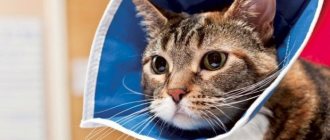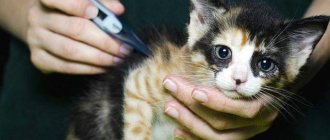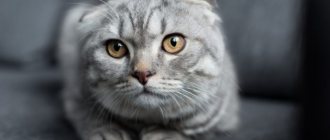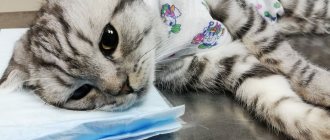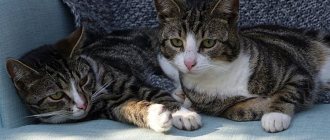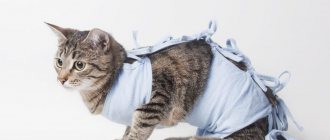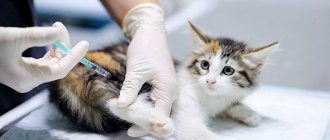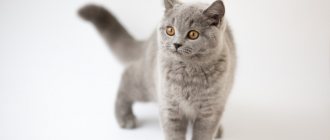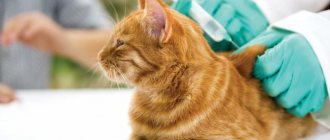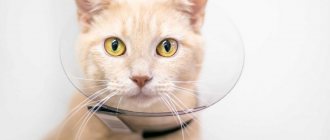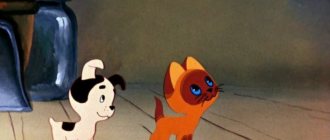Overweight in pets is a common problem that owners tend to underestimate. Against this background, dangerous diseases often develop, some of them irreversible. The sooner you think about how to help your cat lose weight, the greater its chances of a long and healthy life.
But in order to effectively combat the problem, it is important to understand its roots. Only by answering the question of why your cat is getting fat can you take the first step towards its recovery. We hope our article will help you with this.
The animal is overfed
Many owners simply pour dry food into a bowl and allow the pet to eat as much as it wants, adding more as it becomes empty. There is nothing wrong with this, because cats by their nature are not predisposed to overeating. But sometimes “the settings go wrong” and the animal loses its sense of proportion. The reasons for this may be different:
- experienced a period of hunger or malnutrition;
- excess carbohydrates in the diet (sudden surges in blood sugar spur appetite);
- food that is too tasty and difficult to stop eating;
- hormonal changes, taking certain medications.
Cats prone to obesity need to strictly ration the amount of food they eat. If you use ready-made complete food, there will be no difficulties with calculating the diet: all the necessary information is already on the packaging. On our foods it is presented in the form of a table, with a separate column for overweight cats.
When measuring food, you should use a branded cup or an accurate kitchen scale. Cat portions are very small, so even an error of 10–15 grams can interfere with weight loss. Also note that the indicated dosages are calculated per day, and not per feeding.
When feeding homemade food, the diet must be prepared individually. It is important to take into account not only the energy value, but also the distribution of macronutrients (proteins, fats, carbohydrates).
The cat is pampered with treats
Sometimes it’s not the food at all: it is given strictly according to the norms, but every time the cat visits the kitchen, she receives delicacies or treats from the owner’s table. If there are several household members and they eat at different times, the amount of food eaten by the animal cannot be controlled. Some foods that cats love have a fairly high energy value. Even a small piece of cheese, lard or sausage can be significant in the diet of an animal weighing 4–5 kg.
If you find it difficult to resist the attacks of a tailed beggar, simply keep him out of the kitchen during your own meals and snacks. Warn all family members that the cat is on a diet and should not receive anything other than the daily allowance of food. Otherwise, it will be difficult for your pet to lose weight.
The importance of normal weight
If the owner decides to fatten a cat, then it should be remembered that each breed, depending on age and size, must have a certain weight. For example, British people should weigh 5–6 kg on average. The structure of the skeleton also affects the complexion. With the same weight, one cat may appear fat, while another may appear thin. It's all about bone structure and constitution. If the cat's ribs and spine cannot be felt, then he has clearly recovered. If they are too noticeable, then the pet is thin. Normal weight means, first of all, good health and well-being. Owners are often concerned about why their pet is not gaining weight. The reasons can be different: from a banal rejection of the taste of food to serious diseases. This may also be due to the characteristics of the breed and heavy physical activity.
We recommend this article:
How to properly create a diet and feed a kitten
Cats that hunt are almost never fat, since fats and carbohydrates are quickly burned and do not accumulate in the body. And there are pets with individual characteristics that have good metabolism.
The whole day is spent on the couch
In the wild, cats eat as much as they can and don’t get fat. The fact is that they are simply forced to move, getting food for themselves. In addition, they are constantly in a hostile environment, where they have to flee from larger predators. During the winter season, a lot of energy is spent on heating the body, which further increases the overall calorie expenditure.
Of course, in a city apartment it’s impossible to repeat all this, and it’s not necessary, but spending the whole day on the sofa is also not a good idea for a healthy cat. Encourage her to move with interactive toys and teases. Some cats love to play with rubber mice and chase laser pointers. Others become active in the presence of a companion. Look for what suits you.
Wrong diet
Above, we briefly touched on the topic of carbohydrates in a cat’s diet. Now let's look at this in more detail. The truth is that in their natural habitat, representatives of the cat family practically do not eat plant food, except perhaps along with the entrails of a herbivorous prey. By offering a cat food that is half or even more carbohydrates, we are going against its nature. This sooner or later results in disturbances in the normal functioning of the body, one of which is obesity.
The Acana and Orijen diets are biologically appropriate. This means that they are as close as possible to the diet of animals in nature: a lot of protein, a moderate amount of fat, a minimum of carbohydrates. For cats prone to obesity, we have a special food - Orijen Fit & Trim. Its energy value is slightly reduced in comparison with other products in the line and amounts to 371 kcal per 100 g. At the same time, the body receives 47% of calories from protein, 36% from fat, 16% from carbohydrates. The latter are represented by legumes, vegetables and unsweetened fruits, which do not cause sudden surges in blood sugar and, consequently, health problems.
How to find out the amount of carbohydrates in food? Usually this indicator is not indicated in the guaranteed analysis, however, knowing the amount of protein, fat and energy value of the product, you can calculate it yourself. It is important to remember that 1 gram of protein provides 4 kcal, 1 gram of carbohydrates - 4 kcal, and 1 g of fat - as much as 9 kcal. Sometimes it is enough to simply analyze the list of ingredients: sources of carbohydrates should not be in the first three to five positions.
Rehabilitation care
Castration of a cat is a surgical operation that occurs under general anesthesia and involves the removal of the animal's reproductive organs. As a result, a castrated male is no longer able to impregnate a female. After surgery, the pet completely loses interest in sexual life, and the cat’s character and habits change radically. To prevent the negative consequences of castration of a cat, it is important to follow the rules for the rehabilitation care and maintenance of the animal, thanks to which the cat will return to normal as soon as possible.
Treatment of the wound
Caring for a cat after castration primarily involves proper treatment of the postoperative wound. Modern surgical methods involve performing an operation with the formation of a small incision, which heals quickly, and there is no need to remove sutures. But this does not mean that the wound does not need to be monitored, otherwise complications cannot be avoided. Often an animal, experiencing pain, carefully licks the operated area. To prevent damage to the wound, a special collar is immediately placed on the cat’s neck after castration, thanks to which the pet simply cannot lick itself.
Peroxide can be used to treat the wound surface.
It is important to examine the groin area several times a day and if any pathological changes are observed, immediately call a doctor. To prevent infection of the wound, it is recommended to treat it daily with hydrogen peroxide and brilliant green. To make the seam heal faster, you can additionally lubricate it with Levomekol ointment. To prevent post-operative complications, the veterinarian will advise giving the cat antibiotics. The rehabilitation period takes on average 7-10 days. After castration, you can bathe the cat not soon and after consultation with a veterinarian.
How to feed?
In the first hours after anesthesia, the cat often completely refuses to eat. Until the animal has completely recovered from anesthesia, it is not recommended to offer it food. The next day, the pet is given meat broth or liquid oatmeal with ground lean meat. If your cat refuses to eat, you should not force him. It is recommended to carefully monitor him and offer food every 2 hours.
On the 3-4th day, the animals usually recover completely from the operation, so their appetite slowly begins to return to normal. During this period, you can feed your pet boiled beef, rabbit or chicken meat, buckwheat, rice porridge, and boiled vegetables. Veterinarians advise buying special food for a neutered cat, which can saturate the body with necessary substances and at the same time control the pet’s weight. The cat does not gain weight when consuming the product, but remains full and satisfied.
How to organize a toilet?
Washing a cat after castration in the first 6-8 days is strictly prohibited, especially if the wound is still bleeding.
At first, owners will need to put a diaper on their pet.
Often the first hours after surgery, animals are not able to move, so they begin to walk large or small under themselves. A diaper for a cat after castration will help solve the problem. As soon as your pet feels better, the diaper should be removed. While the cat is recovering, it is recommended to fill the tray with light or white litter. If a cat's wound is bleeding when he urinates, you can clearly see it on him. After each trip to the toilet, it is recommended to disinfect the tray, for example, with boiling water, and change the filler. This will help prevent infection of the wound, which is still healing. If urination is difficult, you can ask your veterinarian to prescribe a safe diuretic.
The animal has been spayed (neutered)
There is an opinion that weight problems begin after surgery to remove the gonads. But this does not mean that it is worth torturing the animal and tolerating its behavior during sexual hunting. You just need to take some preventive measures:
- feed the cat after sterilization strictly at the rate recommended by the food manufacturer;
- Weigh your pet weekly and record the result;
- if necessary, adjust the rate downwards.
Practice shows that with a normal diet and sufficient physical activity, most sterilized cats remain in good physical shape for many years. While with improper feeding and a sedentary lifestyle, even an animal with preserved reproductive function can quickly gain weight.
Obesity leads to a host of animal health problems.
Diabetes, liver disease, inflammatory bowel disease and a number of skin problems in cats can be caused by excess weight. In addition, fat animals are at risk of developing arthritis. All this results in the need for constant visits to the veterinarian, treatment, and also negatively affects the quality of life of your pet.
2 stories about children's ingenuity: my daughter was playing and the ball hit the table
A simple underground cooler for drinks from water pipes: instructions
Common care mistake: planting hydrangeas in the shade of trees
The tendency to be overweight is determined by breed
We will not deny that some breeds are more prone to obesity than others. However, this is not a verdict, and everything is again in the hands of the owner. The cat gets fat not only because she is British, but also because she gets too much food. By eliminating the cause, you will get rid of the effect.
Please note that reversing obesity is much easier at the initial stage. If you see that your cat’s sides are rounded, and the spine and ribs are hard to feel under a layer of fat, you should reconsider its diet without waiting for it to turn into a ball.
Why is obesity dangerous?
Obesity in cats is by no means harmless, as it might seem at first glance. What is the danger?
| Musculoskeletal system | Huge load on the musculoskeletal system. The joints suffer greatly and become deformed. With excess weight, a cat is no longer so jumpy, not so dexterous and mischievous. And this only leads to the fact that there is even less physical activity, weight increases even more, and metabolism becomes slower and slower. And if the thick mustache decides to jump, then his joints will have a very hard time. |
| Internal organs | Of course, they have their own fat around them that protects the organ (something like a “pillow” that softens shocks). But if the amount of fat exceeds the norm, then the organ begins to “degenerate”, and the animal develops fatty degeneration (the liver is the first to suffer). |
| The cardiovascular system | We must not forget about the cardiovascular system. The vessels are full of plaques, and atherosclerosis develops. It becomes more and more difficult for the heart to pump blood. Organs do not receive enough oxygen and nutrients because of this. |
| Metabolism | Obesity is not only a consequence of diabetes, but can also provoke its development. Therefore you need to be very careful. And as soon as a cat appears overweight, immediately start feeding it and look for the cause of obesity! Otherwise, after some time you will have to treat a cat with diabetes. |
The pet is seriously ill
Rarely, there are situations when weight gain is caused by diseases that require immediate treatment. The specific cause here is difficult to determine only by external signs: consultation with a veterinarian and a full examination are necessary.
Fasting is contraindicated for cats! The daily norm can be reduced by a maximum of 10–20% and it is better to do this gradually, monitoring the pet, especially if it has any health problems. If, despite your best efforts, the weight does not decrease, it is wise to consult a veterinarian.
